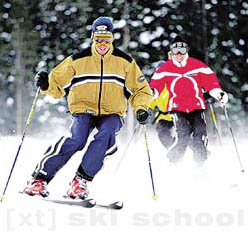|
Custom Boot Stretching: Feet still hurt? customize the shell
Not only do the footbeds make a difference, but the actual shape of the boot can be modified to give a comfortable fit. New skiers always complain about boot fit. They always talk about tight spots or places in the boot where the foot rubs creating a "hot spot" (this is where blisters form). Once again, the way to make a perfect fit right out of the box is to get the boot professionally fit.
Once the boots have been worn three or four times skiing, the liners pack out and conforms to the contours of the foot and lower leg. This is why boots are purchased one-half size under the normal street shoe size. Accomplished skiers know the first few days on the new boots will be uncomfortable, so they have learned to endure the pressure, and you will too. If the boot persists to cause tight spots after the initial three day break-in period, take the boot to a professional boot fitter. The fitter can warm the hard plastic shell and expand it at the tight spots with the use of a hydraulic stretcher making those uncomfortable spots disappear. Once the boot is stretched, it usually will revert back to the original shape after a couple months, making another stretching necessary. It's a fairly quick process and takes about an hour. Make sure you are there when the stretching is done. Immediately after it's done, you should be able to put on the boot and feel the difference. If not, make him stretch it again. The best stretching process uses a heat gun to get the plastic pliable. Some shops use a hot water pot, which protects from the possibility of overheating and damaging the boot, but this method sometimes doesn't get the plastic hot enough, so the stretch doesn't take.
Alpine Skiing School section in english version of WWW.SKI.BG is based on
"A Guide To Becoming An Expert: From First Time To A Lifetime"
by John Mukavitz Copyright © 1998

|


